Issue : 1 Article : 8
Protection of the Ankole Long Horn Cattle of Uganda
Elizabeth Katushabe, Pastoral and Environmental Network in the Horn of Africa (PENHA) Uganda, Elizabethkatushabe@yahoo.com , penhauganda@hotmail.com
|
I am a female adult, born and brought up among the Ankole Long Horn Cattle (ALHC) keeping Bahima community of Uganda. I am a member of the Ankole Cow Conservation Association (ACCA), which is campaigning for ways to ensure that this great indigenous breed does not become extinct. I own 50 pure Ankole Long Horn Cattle which I graze on family land in Kijumba, Ngoma Sub-County in Nakaseke district of the central part of the Cattle corridor of Uganda. With the use of the LIFE method, I supported some Ankole Long Horn cattle herders of Nyabushozi County, Kiruhura District to document the Ankole Long Horn breed. What I hold in high esteem; By; Elizabeth Katushabe for Pastoral and Environmental Network in the Horn of Africa (PENHA) Uganda (January to June 2015) |
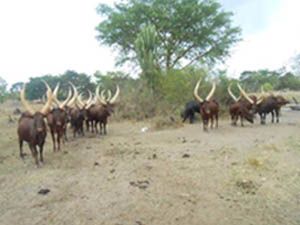 With the Ankole Long Horn cattle, we face the future with hope because despite the harsh conditions, they gracefully stand up resiliently! |
|
INTRODUCTIONPENHA (Pastoral and Environmental Network in the Horn of Africa), supported by LPP (League for Pastoral Peoples and Endogenous Livestock Development), with funding from the Erbacher Foundation, undertook the following project: “Conservation of indigenous Ankole Long Horn Cattle for insurance, sustainable livelihood, poverty reduction, culture and food security in Nakaseke and Nakasongola districts in Uganda” The overall goal of the project was: To promote and protect the Ankole Long Horn cattle by empowering the breeders and keepers of the breed to protect it themselves. The project duration was from January to June 2015. During the implementation of the project, PENHA Uganda carried out the following activities; there was development of promotional materials, i.e.3000 flyers and 1000 badges. These were for making all stakeholders aware of the values of Ankole cattle. Since February 2015, 500 flyers and 150 badges have been disseminated to several stakeholders and mainly herders. There were pre-visits, which aimed at collaborating with government institutions and departments such as the National Animal Genetic Resource Centre farm located in Njeru from where we accessed research data on qualities of Ankole Long Horn cattle. We visited sub-counties of Ngoma and Wabinyonyi in the districts of Nakaseke and Nakasongola, respectively. Here, we met sub-county leaders and district officers such as the National Agriculture Advisory Services co-ordinators, the sub-county chiefs and the elected local leaders. The local people referred us to herders who still own relatively big herds of pure Ankole Long Horn cattle whom we visited and found out why they still rear the indigenous breed. We held a consultative meeting in Ngoma, Nakaseke district aimed at educating and raising awareness of stakeholders about the importance and value of the Ankole indigenous breed for the livelihood of the herders and for biodiversity. Herders were also informed about the importance of bio-cultural community protocols. The meeting brought together leaders from sub-counties, key individuals and opinion leaders in the communities. Skits, local radio stations, UBC Buruli FM and Kitara FM were used to explain and promote the values and importance of the indigenous breeds (Ankole cattle and others) – for e.g., in conservation of biodiversity, resilience in harsh environment and climate change, sustainable livelihood and food security. These were broadcast for 30 days on each radio station (23 March – 22 April and 15 April-15 May 2015 on UBC Bululi FM and Kitara FM respectively). |
||
ACTIVITIESPre-visit to government institutions and private initiativesNational Animal Genetic Resource Centre – NAGRIC and Data BankThe Animal Genetic Resource Centre is a government institution established to conserve valuable animal genetics. It has a data bank in Entebbe and several government ranches and stock farms. Nshaara ranch is specifically used for selecting and conserving the Ankole Long Horn breed. Njeru stock farm in Nyenga, Kayunga district: The farm was established in 1969 as a dairy unit for multiplication of livestock. There are both indigenous (Ankole) and exotic cows, a piggery, 130 acres of maize kept in silo bank (130 tons of animal feed). There are exotic breeds of cattle such as Friesian, Siwarls and Ayrshire. Artificial insemination is used to obtain the best genes and it takes 7 years to determine the best genes. Ankole Long Horns on the farm use bulls for mating. Nshara Farm in the south western part of Uganda was established purely for conservation of Ankole Long Horns. |
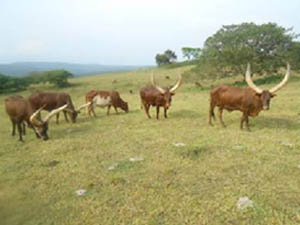 Ankole Long Horn cows at the National Animal Genetic Resource Centre’s Njeru stock farm |
|
Lessons learnt:
1) Herders should be imparted crucial information such as “the Bihogo” coloured Ankole Long Horn breed, grows faster than the Boran, which they are replacing it with.
2) The East African standards for the dairy sector will help in the conservation of the Ankole Long Horn breed since they consider high butter content, which can only be obtained from the Ankole cow milk.
3) National Animal Genetic Resource Centre and data bank (NAGRIC) can help herders on different issues such as follows.
- Organise herders into associations and train them in record keeping
- NAGRIC can help herders select high milk-producing cows
- Support for creating market linkages
- Organise freeze branding instead of using hot metal
- Carry out a baseline survey to find out the challenges
The senior manager mentioned that if people look for quick profit today, they will lose more profit in the long term.
Kiira Jersey Dairy
I visited a British couple living and farming in Eastern Uganda. The visit was aimed at learning how they have specialised in rearing the Jersey cows and about the niche marketing of its milk and dairy products.
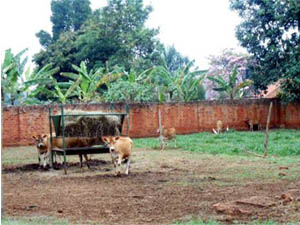 Some of the Kiira Jersey cows reared in Kiira farm |
They said the Jersey cow’s milk is similar to Ankole Long Horn’s milk with high fat content but the Jersey is also a high milk producer. Their market is the expatriate community, which lives and works mainly in the eastern town of Jinja and also in the capital city, Kampala. This community prefers Jersey pasteurised milk, ice cream, yoghurt and butter. They said that they started with zero grazing on a small piece of land but now they have rented some land to expand grazing space. They said that they try to conserve the grazing grass by carrying out rotational farming, and they reduce ticks by making tick barriers – 4–5 metre wide ruts, i.e. bare soil and burnt grass in paddocks seasonally. They agreed that they have to use accaricides (e.g. Delta methrene spray) to kill ticks and antibiotics to treat diseases; but hastened to say that they use withdraw method during treatment. They have a long-term plan of establishing a model training centre for demonstrations and developing vocational skills for farmers. |
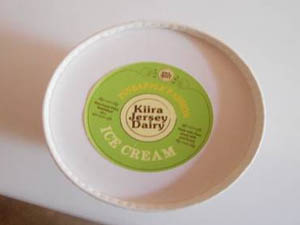 Ice cream produced by Kiira Jersey Dairy cottage industry mainly sold to the expatriate community |
Pre-Visit/Baseline Survey, Ngoma, Nakaseke District
The pre-visit to the district aimed at introducing the project to the herders, the civil servants and elected leaders of the project area. Some of the leaders and herders explained why they had opted for the indigenous breed while others shared information on why they had crossed the indigenous breed with the exotic breeds. They also shared details of the advantages and challenges they had experienced in the years they had reared the cross breeds; and also the way they are responding to the challenges. The sub-county leaders guided us in selecting the herders for us to visit.
Some reasons for the herders to have kept the indigenous Ankole Long Horn cattle
Matongo George – Kyeshande: He tried crossing Ankole cattle with Friesian, but it did not yield good results. So, he is back-crossing i.e. using Ankole bull to breed with the crosses.
He said that rearing cattle is a business like any other. Ankole Long Horn cattle die due to accidents but not due to lack of 24-hour watch! He emphasised that when one invests in the Friesian rearing business, one will never do any other work or attend to any other duty or commitment; for e.g., no attending wedding parties or funerals, or visiting, because one needs to be present all the time. Then, one becomes a slave and yet there is no profit in the whole venture.
|
George said that he owns cross-bred animals which produce 500 litres every day. However, the income from the milk does not support these cattle, which means he does not get enough money to provide all the inputs to take care of them. (N.B. Bahima would not reveal how many heads of cattle owned by them. Traditionally, it was taboo among Bahima to mention numbers.) He said that under normal circumstances; when one owns cows, he is a boss. However, with the Friesians, owners are slaves. Workers abuse the owner, they mistreat or mishandle their livestock and at times the cows die due to the workers’ carelessness. However, the owners ignore the workers because they need the services of the workers, especially to milk. At times, workers go on a strike because they know that the owner needs them. They ask him to buy them illegal herbs (marijuana) for chewing because they know he needs them to stay on the farm looking after the cows. George said that even after all the 24-hour care, the cows still die. He gave an example of a prominent rich man who had died on a Sunday and by Thursday, half his herd was dead and the calves, if not cared for would suckle a lot of milk and die in one month. He said that cows of farmers who do not live on the farm suffer more. He emphasised that if one does not live at home and is a woman, then one should not invest in Friesian crosses because even when she is living there, she cannot give an injection to the cow. He gave an example of another friend who has been keeping hides of dead Friesian crosses so that he can count the dead. This caused an illness that took him to Bangalore for treatment. |
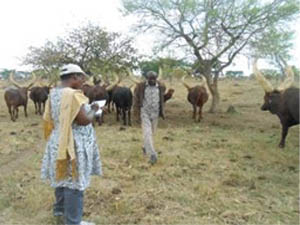 George Matongo explains his “bondage” experience with rearing of the Friesian crosses unity |
Exotics are a curse, people hold onto them thinking they are saving for the future, yet they often die due to East Coast fever. Since they are considered very expensive, herders do not want to give them to friends as gifts as they traditionally used to do with Ankole breed. When an important guest arrives, one cannot slaughter an exotic bull as a sign of welcome. People do not want to give them as dowry (bride price) which at times causes conflict in families. Another big challenge is that offspring of some exotic breeds are too big to be produced by local breeds; the calves die, the mothers’ uterus burst and thus herders lose.
But the farmer expressed that Ankole Long Horn Cattle are special. I had visited the farm during the peak of the dry season, but he explained that they were surviving the drought and that no one had died. He was confident that they would survive until the rains. They would look emaciated during drought but would not die. He explained that 400 heads of cattle can survive on 1 square mile of land. Ankole breed cow can give birth to 20 offspring . Rearing Ankole breed has provided adequate income for paying school fees, buying land and for paying medical bills. “They strengthen relationships because we gift them to friends. If there is any problem, I can run with my cows. They can escape and find greener pastures far away from here.”
Tibasiima Moses from Migaani Parish in Ngoma Sub-County said he still rears the indigenous Ankole cattle because they give him peace of mind. He said that since he has some other alternative source of income, he does not stay on the farm. So, he does not worry about the cattle even when he leaves them in the hands of paid workers.
Nayebare Kyamuzigita (Deputy Resident District Commissioner - RDC, for Nakaseke district) His home is in another part of the cattle corridor, Kabura district. He has a big herd of Ankole cattle breed. He is chairman of the group that has been mobilised by the President of Uganda, to conserve the Ankole breed by improving it for more production (meat and milk). He also mentioned that the group had a plan to request the government to allow them use part of the government ranch to carry out their conservation project.
Dan Rwekurumeeta – Ngoma Sub-County Chief Kamusenene: The chief said that he also believes that the Ankole cattle is very important in many aspects. He narrated his story of how he sold Ankole Long Horn Cattle to buy land. “When catered to, our cows can produce a lot of milk and when fattened, can fetch high price because at the same age, they weigh more than the Friesian cattle.” He said that most people now understand that it is risky to let their cattle become extinct, but they need sensitisation to understand how they can protect them. He suggested that if an individual owned 200 acres, then one can graze Friesians on 100 acres and Ankole cattle on the other 100 acres. He said: ”By losing our Ankole breed, we are not only losing cattle but our culture and that our children have to go home and learn the work of their parents”. He said that there is still opportunity to protect and sustain the Ankole cattle, for e.g., ”A Turkish guy wants to carry out a meat export project, this will be known as a Special Economic Zone (18 square miles area). It would be similar to an industrial area with schools and hospitals. The local community will act as out growers”. He also thinks that part of Kaweweta forest reserve, located in neighbouring Kinoni Sub County, with permission from responsible authorities, could be used as a conservation farm. Herders could be sensitised, their views sought, a cooperative or an association formed, and a concept developed and implemented. There would be need to fence off some land and provide water.
Frank Matongo - Kashozi: Frank said that he loves the Ankole Long Horn but does not have enough land to rear both. However, he appreciated that the Ankole breed was more economical compared to the exotic crosses. He noted that his father had both breeds and that only two workers were employed for the Ankole breed but the exotic breeds needed 12 workers. (He did not mention how many of each type.).
|
Beatrice – Kashozi: Beatrice owned Ankole cows but is currently crossing them with a Frisian bull. She said that she is doing this to increase her income. However, she added that the crosses are giving her much stress. She informed me that she is on treatment for high blood pressure and therefore she spends much of the milk sale income on hospital bills. Kiiza Isanga (Chairman Local Council III) – Kigweeri: He said that this project is in line with the president’s proposal of conserving the indigenous breed. He noted that a committee has already been appointed to mobilise the richer herders and sensitise them to save portions of their land for the Ankole breed. Small carrying capacity of land should not be an excuse because many herders have a lot of space and can manage to graze both breeds. He said that Ankole Long Horn cattle can survive in all situations, but exotics such as Boran need a lot of grass. ALHC can walk long distances to access grass and water and their milk is tasty. He advised that herders can paddock off some acres for grazing 40 Ankole cattle. He supports the idea of a farm for selecting the best bulls for breeding. Yokaana Kyomukuuku – Kijumba, Ngoma: He also tried rearing exotics but has been disappointed so far because Friesians need a lot of input. Those of us who sell milk do not necessarily get profit because most income is spent on drugs. He said Ankole cattle are still very important; for example, last year, when he had to pay bride price (dowry) for his son’s wife, the in-laws insisted that they wanted Ankole cows. |
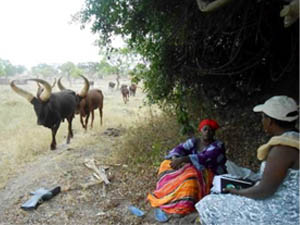 Elizabeth holding a discussion with Beatrice |
|
Beshweri Kashaija (Chairman of the committee of rich people supposed to implement the president’s proposal to conserve the Ankole) – Karyaburo: He was happy that PENHA was involved in an important project of sensitising the community about protecting the Ankole breed. He mentioned that this was in line with what the president had talked to them about. He said that we should educate people such that they should not only consider the beauty of the cow but also its other values such as resistance to harsh conditions. He mentioned that the Bahima standard Ankole cow “Bihogo” was not very beautiful but it produced a lot of milk and therefore people should be encouraged to breed it for this purpose. He informed us that His Excellency, the President was providing bulls (not very beautiful ones) to the rich people. These were good for milk production; their offspring could produce 5 to 7 litres of milk. The president has told people not to destroy cows for being ugly. Beshweri said that even though he had crossed some of his Ankole cattle, he still treasured the Ankole cattle breed because he had 300 herds of Ankole breed. He sold them, bought a vehicle and constructed a house. He said a fattened cow could fetch 3 million Uganda shillings (Euros 1000). He said that sometime back, during an epidemic of East Coast fever; he lost 30 heads of Friesian crosses that had been producing 20 litres of milk each. However, he said that during their meeting with the president, he had promised them that he would suggest a way of destroying the ticks. Erick Kamafaari – Kijumba: He said that he sold Ankole cows to buy extra land but that he was now making a few changes by paddocking some land near his house so that he could keep Ankole cows to produce milk for home consumption and stop drinking milk from Friesian cows. He said that his neighbour does not drink milk from Friesian cows. He explained that he appreciates the value of the Ankole cows and that some can produce 7 liters and that they can walk for 4 miles without experiencing migration stress. He said that 300 acres can feed 80 Friesians compared to 160 Ankole cows because Friesian cows eat a lot. He is aware that Ankole cow’s milk is healthy because during the 1979 war, he had lived on blood and raw milk for one year and he did not fall ill. The money he got from selling milk of Friesian cows took him to the hospital (he is diabetic and is on treatment). He still keeps Ankole cows because he loves beautiful cows. He said that during an East Coast fever epidemic, he lost Friesian crosses (6 bulls and 4 heifers) but the Ankole cows survived. |
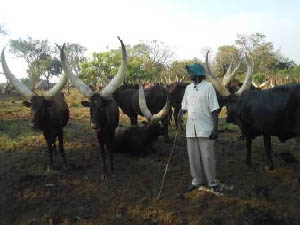 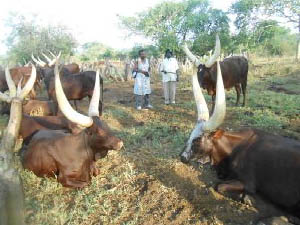 Beshweri Kashaija, Chairman of the rich Ankole cow owners in Nakaseke district |
Ankole cows live and reproduce for so long, for e.g., he said he was given a cow “Gaaju” which now has 10 offspring and is still going strong. It produces 5 litres of milk. He promised to give me its bull “Ruroko” rwa Gaaju for breeding (after weaning).
He also mentioned that Ankole cows eat less grass compared to Friesian. He was disappointed when he spent 300,000 Uganda shillings (Euros 300) on a very young bull planned for breeding that died even after treating it with expensive drugs. Has had an Ankole bull that fell ill but somehow it survived.
Frisians crosses have given him much trouble, for e.g., a lot is spent on the 300 cows on druges and manpower (5 workers) and yet 70 Ankole cows have only one worker and less cost of drugs.
He also repeated what others had mentioned that exotics make owners lose peace of mind and therefore in the long term, they will not survive. He believes that the many new different diseases are a result of drugs used to treat exotic breeds. He also noted that cutting trees deprives cattle of shade; yet, they do this to clean the environment and create more grazing space for the exotic breeds. He is now planning to invest in a big valley tank so that cattle can drink from nearby source.
A trader who normally buys his cattle for slaughter, Nsubuga Moses (a.k.a. Mudinka of Bombo Slaughter House) – supported him by emphasising that Ankole breed meat is the best; it is tender, tasty and it takes longer before going bad.
Pre-Visit/Baseline Survey, Nakasongola District: I visited UBC Buruli 107FM, in Nakasongola Town Council and discussed how to develop a spot advert for promotion of the indigenous breeds. It was broadcast 5 times daily for 30 days (23 March to 22 April 2015).
Wabinyonyi Sub-county, Nakasongola district: I met Samuel Kaweesi, the chairman of Nakasongola Pastoralists Association (NPA), a member organisation of COPACSO. I briefed him about the project. He was very enthusiastic and said that in Nakasongola district, during the dry seasons, the herds die in hundreds and many landless herders move around with their indigenous breeds in search of any available water and grass. He emphasised that the exotics normally die first due to heat stress.
|
We visited the different local leaders to introduce the project in the district. These included the Chief of Wabinyonyi sub-county, Begumye Robert. He appreciated the great concept which he said was the best way for a sustainable future for our herders. We then met Senyimba Charles Daniel, the Local Council 3 chairman. His thanked us for talking about reality and that many people who are trying out the exotics are losing a lot since they cannot survive during the dry season. He said that herders should be encouraged to rear beef cattle instead of focusing on milk-producing cows which cannot survive in the harsh climate. He said that he is also the Chairman for Nakasongola District Wildlife Association. He added that wealthy pastoralists clear bushes, in the name of cleaning farms for their exotic breeds which hurts him because they destroy potential wildlife attraction. He said that the leaders have tried to talk to herders about bush clearing but in vain. He said that he supports indigenous breeds because “when you marry a new wife, you do not chase away the old one”. He added that people can rear indigenous cattle breeds on one paddock and use the other paddock for exotic breeds. He promised that leaders would support the awareness project. He informed us that under a government programme called “Luwero Rwenzori”, five exotic heifers were distributed but only one has survived in the previous year because not many people can manage the exotics. |
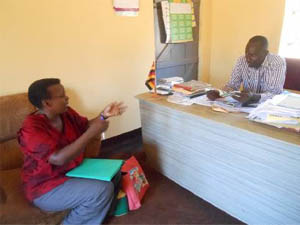 Meeting Charles Senyimba,the LC3 chairman of Wabinyonyi sub-county in Nakasongola district |
He said the project of Uganda Wildlife Authority is one of the great ideas to encourage people to stop clearing their land and thus protect wildlife. In 2009, when the Uganda Wildlife Authority initiated a project in the three pastoralist districts (Nakasongola, Luwero, and Nakaseke), herders were given 50% share if a wild animal was hunted from their land. He said that this project was doing well because people supported it. (His mother has been a beneficiary of this project, she received 500,000 Uganda shillings or Euros 170. and now she is always crying out to her son to stop cutting trees from the farm.)
|
Landless pastoral communities near Kaishagara Forest Reserve: We met a group of landless pastoralists who had camped near a government valley tank. There were five families who had moved over 50 km from where they normally graze their livestock. One of them Rwamangwa Steven, said that he had moved to this area because he does not own land. His family lives (squats) on some other people’s land and they have to pay rent annually, during the dry season. Water dries up and there is not enough grass; so, the owner does not allow them to keep all their herds on his land. Therefore, they move further to look for greener pastures. There are several challenges when herders burn the grass and the livestock will have nothing to graze upon. This was traditionally okay because the herders would consider the rainy period and burn the grass to plan for the new growth, which would be more nutritious. However with climate change, no season is predictable anymore. The livestock therefore at times eats the cultivators’ crops, which leads to conflicts. During our visit, we learnt that some cultivators had used pangas to cut seven cows because they suspected that they were the ones that had destroyed their gardens. So, conflicts are unavoidable. |
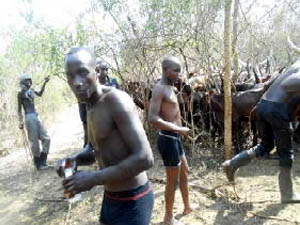 | 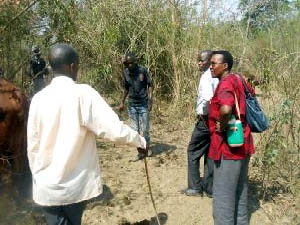 |
| Nomadic herders spray chemical veterinary drugs to kill ticks while they camped at Kyambogo near the government-owned valley dam in Kakoge Sub-county, Nakasongola district. (Then, it was the only available water source about 40 km from where they normally live.) | ||
Launch of the Media Handbook on Pastoralism by Coalition of Pastoralists Civil Society Organisation (COPACSO), 11 March 2015 (refer to Media Handbook)
COPACSO was started in 2005 to create a voice for pastoralists to be heard in the Poverty Eradication Action Plan (PEAP). It has 17 ordinary members and 2 associate members. COPACSO has been able to build the capacity of its members, has set up a national committee to work on Rangeland Management Policy, has ensured that pastoralists participate in land policy development process and also participate in African fora at the global level (FAO, CELEP, and WAMIP). PENHA as a founding member and Treasurer of the coalition, we were invited to preside over the launch.
The media handbook aimed at sensitising the media about objective reporting regarding pastoralists and informing them about the role and contribution of pastoralism despite several challenges. An interview with 14 media houses regarding the contribution of pastoralism was conducted.
Consultative Meeting, 8 April 2015, Ngoma Sub-county, Nakaseke DistrictConsidering that it was during the peak of the dry season, when herders are very busy searching for water for their livestock, the meeting was well-attended by 89 enthusiastic participants (80 males and 9 females). An overview of the meeting was given and participants were asked why they were destroying their Ankole indigenous breed. They were asked to mention the values of the breed and why we need to protect it. Finally, participants were asked to suggest what should be done in order to protect the Ankole breed. Participants provided inspiring ways for protecting the breed. I suggested that if the animal genetic resource centre agreed to support us, I would offer my farm for pilot breeding. Way forward
• Some herders proposed to form an association of Ankole cattle keepers and others suggested the strengthening of the existing one initiated by the president. Four herders were selected to lead the plan for the future. |
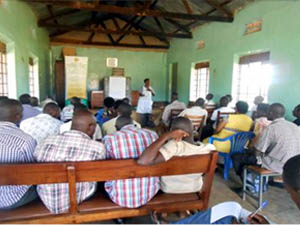 During the consultative meeting at Ngoma Sub-county main hall |
Results
• Spots on local radio stations, UBC Buruli FM and Kitara FM were used to explain and promote the values and importance of the indigenous breeds (Ankole cattle and others), for e.g., in biodiversity, resilience, livelihood and food security. These were broadcast for 30 days on each radio station (23 March – 22 April and (15 April - 15 May on UBC Bululi FM and Kitara FM, respectively). People have been calling back thanking us for the good advice. Others are asking if we can provide Ankole breeding bulls which can produce offspring with give lot of milk.
• Since February 2015, promotional materials including 3000 flyers and 1000 badges have been produced and these are one way of sensitising and making all stakeholders aware of the values of Ankole cattle.
• During the pre-visit, Erick Kamafaari, promised to gift me an offspring bull (Ruroko rwa Gaaju for breeding) from one of his treasured cows “Gaaju” which now has 10 offspring and is still going strong. It produces 5 litres of milk per day. He did this as a sign of appreciation for my effort to promote the Ankole breed.
• Rwakampangi, one of the participants during the consultative meeting, called me over telephone on 7 May 2015 to inform me that the prices of Ankole bulls was increasing since people were demanding them to restock after the consultative meeting. I requested him not to sell his bulls at prohibitive prices, especially to people who are responding to our campaign.
• A youth named Byarumu called me on 25 May 2015 asking me about how we can work together after the consultative meeting. He informed me that he had participated in the meeting and that his family rears pure Ankole cows.
Limitations
• Due to insufficient funds, the project covered a smaller part of the cattle corridor (3 sub-counties and 2 town councils) in the two districts.
Conclusion
With support from LPP and funding from Erbacher Foundation, PENHA successfully implemented the 6-month project aimed at the conservation of Ankole Long Horn cattle breed. All planned activities were carried out, for e.g., pre-visits to government institutions and sub-county leaders were carried out, promotional materials were developed and are being distributed to stakeholders, radio skits were developed and aired on two local radio stations UBC Bululi 107 FM and Kitara FM in both districts of Nakasongola and Nakaseke, respectively. A consultative meeting was held and there was a very fruitful discussion.
During the pre-visits and the consultative meeting, about 200 stakeholders were reached and informed about the importance of protecting the Ankole Long Horn cattle and most of them acknowledged the special traits and values of the Ankole cow breed. They agreed that they should revitalise their traditions of sharing with others the good bulls in order to sustainably protect the best traits of the Ankole breed.
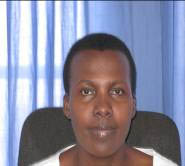 ELIZABETH KATUSHABE
Pastoral and Environmental Network in the Horn of Africa (PENHA) Uganda |
I am a female adult, born and brought up among the Bahima community of Uganda keeping Ankole Long Horn Cattle (ALHC). I am a member of the Ankole Cow Conservation Association (ACCA), which is campaigning for ways to ensure that this great indigenous breed does not become extinct. I own 50 pure Ankole Long Horn Cattle, which I graze on family land in Kijumba, Ngoma Sub-County in Nakaseke district of the central part of the Cattle corridor of Uganda. With the use of the LIFE method, I supported some Ankole Long Horn cattle herders of Nyabushozi County, Kiruhura District to document the Ankole Long Horn breed. What I hold in high esteem; |
